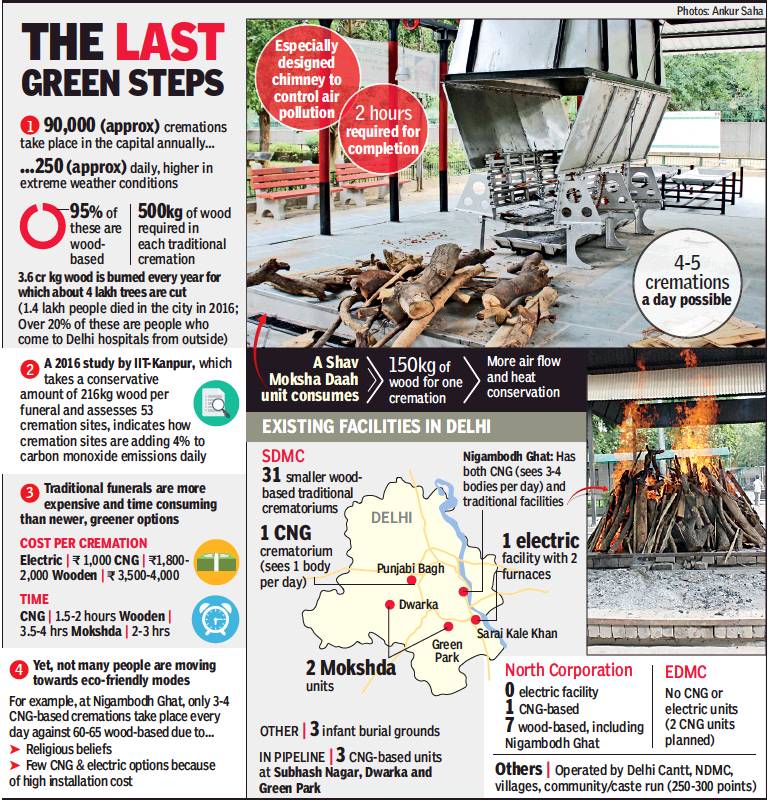Cremations in India
(Created page with "{| class="wikitable" |- |colspan="0"|<div style="font-size:100%"> This is a collection of articles archived for the excellence of their content.<br/> Additional information ma...") |
Revision as of 20:54, 18 September 2018
This is a collection of articles archived for the excellence of their content. |
The ecological cost
Delhi cremations consume 4 lakh trees a year

From: Paras Singh & Mayank Manohar, Nearly 4L trees lost to cremations every year, but Delhi finds it tough to make green shift..., August 28, 2018: The Times of India
95% Of Funerals Wood-Based Despite Cheaper Alternatives
Despite several interventions by courts and introduction of new technologies, wood-based traditional funerals continue to constitute more than 95% of cremations in Delhi. The latest statistics released by the government’s directorate of economics and statistics shows that over 1.4 lakh people had died in the city in 2016 and the number has been consistently rising.
The corporations’ public health departments estimate that around 90,000 cremations take place in Delhi annually. “Around 80,000 woodbased cremations are taking place every year,” said Lallan Verma, a senior official.
Each wood-based traditional cremation uses 400-500kg wood, requiring over 3.6 crore kg wood — equivalent to 4 lakh trees — in Delhi’s burning ghats every year. Mokshda, an NGO working in the cremation sector, found in a survey of 3,000 cremation grounds that on average, an Indian tree yields 80-100kg wood.
A study conducted in 2016 by IIT Kanpur, which considered a conservative amount of 216kg wood per funeral and assessed only 53 cremation sites, indicates how these are adding 4% of toxic carbon monoxide emissions to Delhi’s environment every day. The study concludes that over 2,129kg carbon monoxide, 33kg sulphur dioxide, 346kg PM10 and 312 kg PM2.5 were being emitted every day. With the population rising at a brisk pace, the numbers are only getting worse. While hearing a 2016 case, National Green Tribunal directed the Union environment ministry and the Delhi government to initiate programmes to provide alternative modes of cremation as the “traditional method of wooden pyres emitted hazardous pollutants into the environment”. But not much has changed on the ground.
Some of the biggest cremation grounds in the capital are at Nigambodh Ghat, Punjabi Bagh, Lodhi Road, Sarai Kale Khan, Green Park, Dwarka and Karol Bagh.
Though the alternative modes are cheaper and quicker, people still opt for the tradition. “Though a wood-based cremation costs Rs 3,500-4,000 (two to four times higher than CNG and electric options) while also taking more time, religious beliefs come in the way as people want to follow the scriptures,” admitted a senior supervisor at a cremation ground. “When someone has lost a relative, environment is the last thing on his mind. Some believe this is the only way to get mukti.”
The installation cost of alternatives is also high and the cash-strapped local bodies are trying to set up these units by taking CSR help from private companies. “The cost is Rs 2 crore for a CNG unit and Rs 1.5 crore for an electric unit while a site for traditional funeral will need just Rs 50,000 to Rs 1 lakh. When we can’t pay salaries to our employees, how do we set up such costly infrastructures on our own,” an north corporation official said.
Delhi has only two electric crematoriums at Lodhi Road and Sarai Kale Khan while CNGbased furnaces are available at Nigambodh Ghat and Punjabi Bagh. The south corporation is about to set up three more CNG units in Dwarka, Subhash Nagar and Green Park. However, people hardly opt for alternative modes. Situated along the Yamuna — Niagmbodh Ghat, the biggest cremation ground in Delhi — got CNG crematoria in 2012 but out of over 21,000 annual cremations, hardly 1,100-1,200 are carried out in the green mode.
Around 60 wood-based cremations are performed every day at Nigambodh Ghat while the CNG option is used by only three-four people, said Avdhesh Sharma, its supervisor. “The numbers get a bit higher during extreme summer or winter.”
However, seeing the overall trends, the corporations are slowly moving towards CNG systems as electric units are getting less and less utilised due to foul smell and tripping issues.
A senior municipal official also said, “As the consumption is so high, huge volumes of forest wood get smuggled from Bihar, Jharkhand, MP and eastern parts of India, involving huge sums.” Still, the south corporation has installed four shav moksha daah units in Green Park and Dwarka, which not only use half the amount of wood than a traditional pyre but also help people fulfil their ritualistic aspirations.
Rajendra Kumar, who performs final rites at Green Park, said though he was “in favour of eco-friendly measures, only time will tell how much people want to change”.